- Home
- Resources
- Best Paper for Coloured Pencils
- Black paper
Colored Pencil on Black Paper: Techniques, Tips, and Inspiration
Black paper isn't just a backdrop - it's your secret weapon for creating artwork that practically glows. While most artists reach for white paper by default, switching to black can turn ordinary colored pencil drawings into something spectacular. Let's explore further.
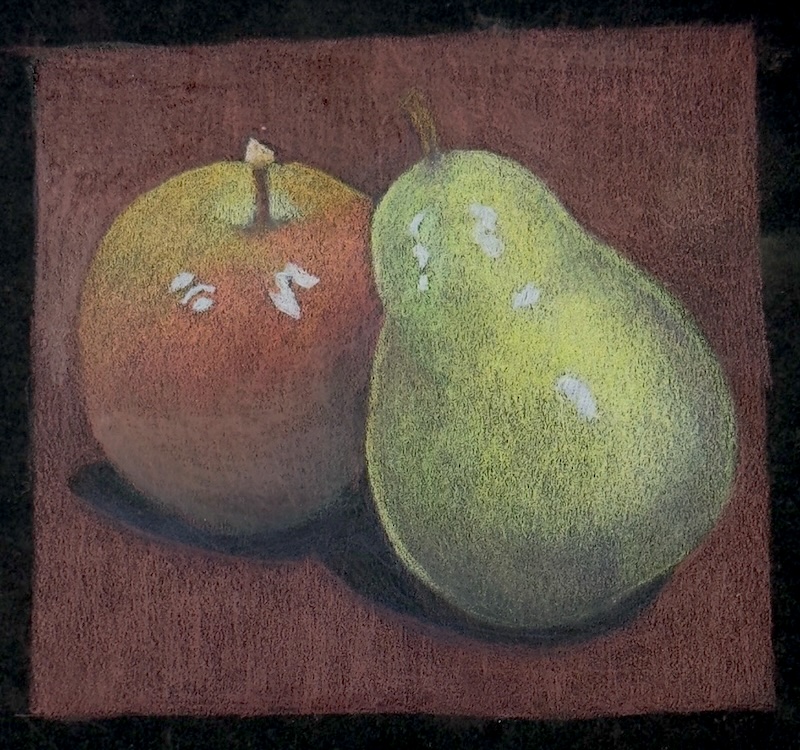 An early attempt at a still life on black paper
An early attempt at a still life on black paperWill Black Paper Fade?
Not all black papers are created equal, and paper quality matters.
Here's a quick test I swear by: Put a sheet in your sunniest window for a month. If it stays rich and dark, you’ve found a keeper. If it fades, save it for thumbnail sketches.
Pro tip: Skip the bargain craft papers. They might look tempting, but they lack the longevity of archival-quality options. Invest in quality—your future self will thank you.
Choosing the Right Image for a Black Background
Black paper brings certain images to life. Here are some ways to make the most of its dramatic potential:
- Look for high-contrast references with bright highlights and vibrant colors.
- Apply colours directly, without a white base underneath.
- Start with harder pencils and layer with softer ones for detail.
Crabapple Tea (pictured here) was an initial experiment on black Stonehenge paper using Faber Castell Polychromos and Caran d'Ache Luminance pencils. It was based on a photo by Gemma Gylling CPSA.
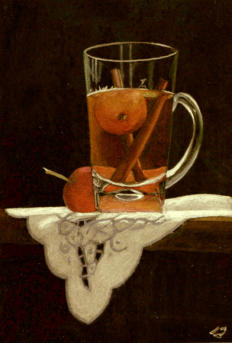 Crabapple Tea
Crabapple TeaBlack paper also works brilliantly for white-on-black drawings, as Carol demonstrated with her owl illustration below, although she added a touch of colour in the eyes and bill.
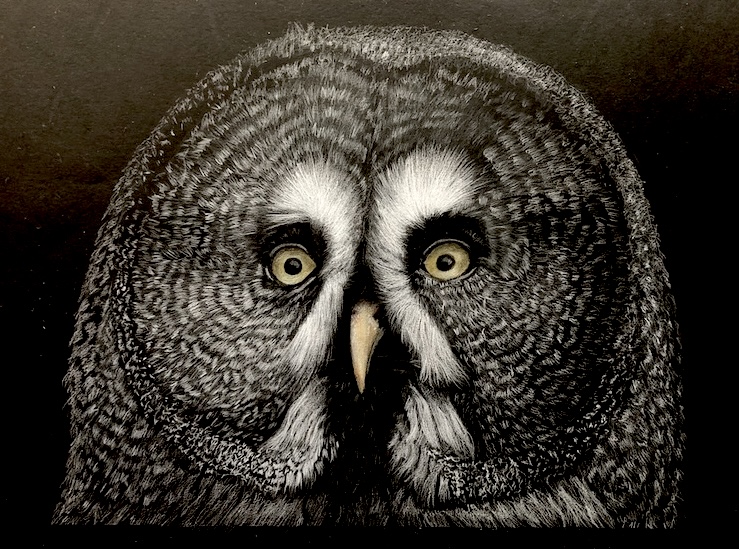
Let's look at the process
Sketch your outlines with white pencil before applying coloured pencil on black paper.
The photos below show the progression from photo to finished piece.
The wooden storefront of this French wine merchant sits within a row of half-timbered buildings. Painting the scene on white paper requires careful attention - especially for the window's interior grill, posters, and text.
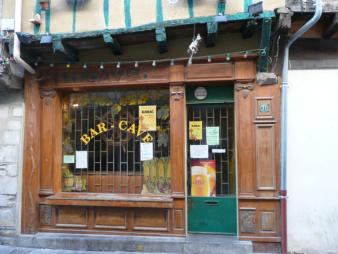 Photo of the French building
Photo of the French building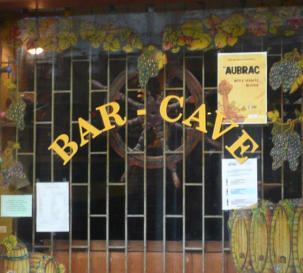 Close up of the window
Close up of the window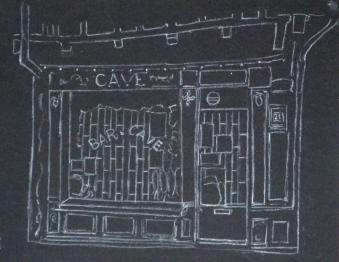 The outline in white pencil
The outline in white pencil Finished drawing
Finished drawingOne afternoon's work produced what Peter modestly calls "a fairly respectable" shop front. The white pencil effectively capturing the details along with the timber-framed upper story.
While not perfect, this piece demonstrates how starting with black paper can offer an effective alternative approach to colored pencil work.
Step by Step Demonstration
Now let's work through a sweet still life step by step.
The reference photo pictures a glass jar of sweets (or candies for my American friends) placed on black mount board. The family had already eaten some before the photo was taken, so some adjustments were needed to the composition during the drawing process.
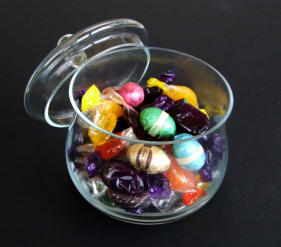 Original photo of the sweet jar
Original photo of the sweet jarIf you'd like to try this picture yourself, you can:
Drawing The Glass Jar
With five essential curves - three on the lid, the jar's top edge, and the bowl - tracing them from the photo may be better than drawing them freehand. This ensures accuracy where precision matters most.
The remaining elements can be drawn freehand.
Choosing the Pencil Brand
With numerous brands to choose from, the pencils to use is the next decision.
You might like to narrow your focus to a single brand of pencils rather than mixing them. This helps you build expertise with that specific pencil brand/paper combination.
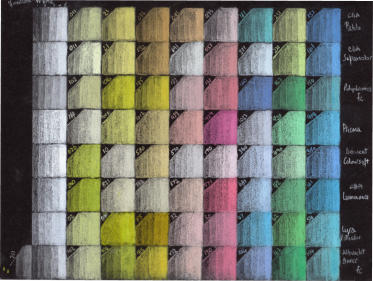
The photo above shows the process of completing a chart using a range of colours from eight different brands. The paper used here was Stonehenge.
Each block shows from 1 to 5 layers of that colour, starting with light pressure and building up to maximum coverage.
The brands used in this photo (from top to bottom) are:
- Pablo
- Supracolor *
- Polychromos
- Prismacolor
- Coloursoft
- Luminance
- Lyra Polycolor
- Albrecht Durer *
Those marked with an asterisk are watercolour pencils and are included to test whether using wet or dry pencil makes any difference to the end result.
Keep in mind that the Faber Castell Polychromos and Albrecht Durer pencils share the same colour range. Likewise with Caran d'Ache Pablo and Supracolour.
The results of the pencil tests
Peter determined there was little difference between the brands. However, the following lead to his choice of working mainly with Pablo.
- Prismacolor and Luminance performed best, being the softest pencils.
- Polychromos and Pablo provided the most options (120 colors each).
- Coloursoft and Lyra Polycolour worked well, despite limited color ranges.
He ended up using Pablo's for the demonstration, but added a few Polychromos for their superior reds. Pablo excels at greens, while Polychromos handles reds better.
The Technique
Start with two or three sweets from the reference photo and position them where you want them to be in the jar.
Work with four versions of each colour - the lightest tint, two intermediate, the darkest shade along with white for the hightlights.
For the foil wrapped sweets, begin with the highlights - let the white extend slightly beyond its actual boundary into the coloured area, then fade it out.
Next, work backwards from the darkest shade in each sweet. When you reach the lightly applied white areas, continue over them to create a smooth gradient from dark to light, perserving the white highlights.
For the transcluent wrappers, identify the colour transitions and test them on spare paper first.
The photos below show the Pablo colours used for each type of sweet

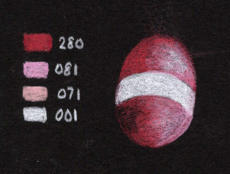
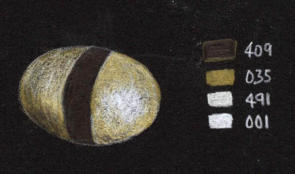
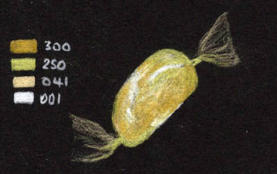
With the method of creating the sweets decided, work on the final piece can begin. The photos below show the progression of the drawing.
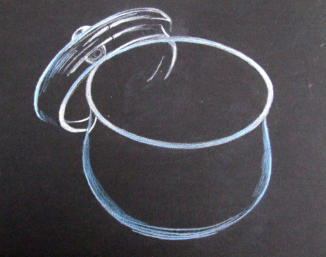
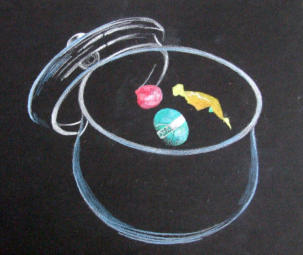

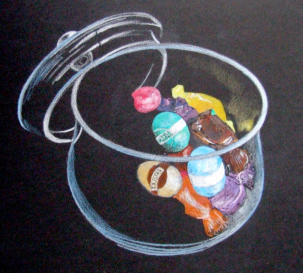
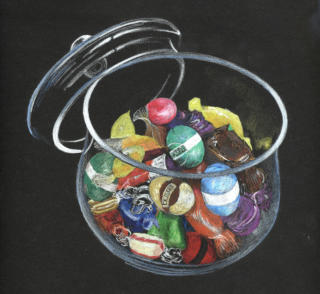
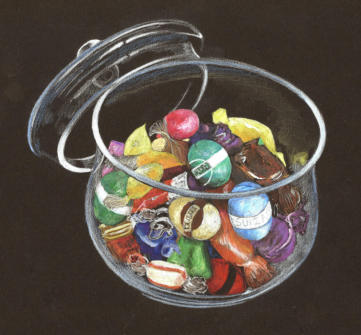
To fill in the missing sweets, it may be necessary to invent some different ones to add variety to the contents of your sweetie jar. If you compare the finished example with the orignal reference photo you will see those that were added.


Adding the finishing touches
The final stages of the drawing involve tidying up edges and completing missing parts on the egg wrappers. Additionally, refine the twisted ends of the transparent wrappers on some of the sweets where necessary. To enhance the visual impact, add richer colors and highlights with fine-pointed pencils.
After applying multiple layers of Pablo pencils, the paper may reach its absorption limit, making it necessary to switch to Luminance pencils for the finishing touches. Their softer texture proves effective for detailed work.
Adding reflected backlight in the glass, using a pale blue subtly enhances the luminosity without overpowering the scene.
Although the scan appears more intensely tinted, the original drawing has a subtler blue tone.
To complete the piece, clean the surface with a sticky BluTac ball to remove any pigment dust and sharpen selected edges with a clean plastic eraser.
Same image, different black paper
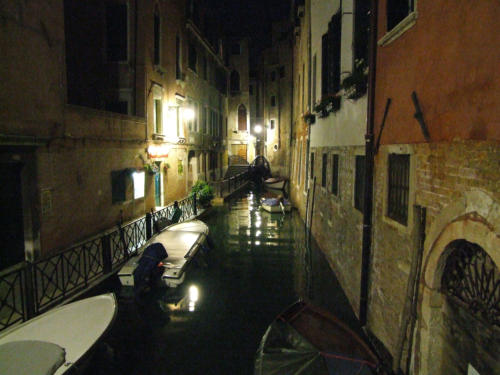
A student of Peter's decided to attempt a reference photo using colored pencil on black paper, despite Peter not having tried it yet.
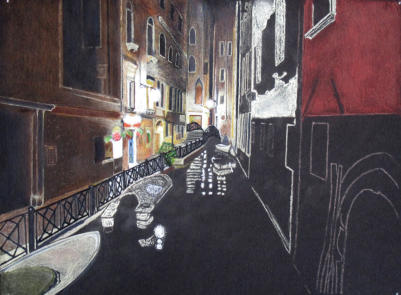
The student chose black Stonehenge paper, known for its smooth, absorbent surface, and used Polychromos pencils. An in-progress scan was shared with Peter, who was unsurprised to see the bricks prominently featured in the finished piece, considering the student's engineering background.
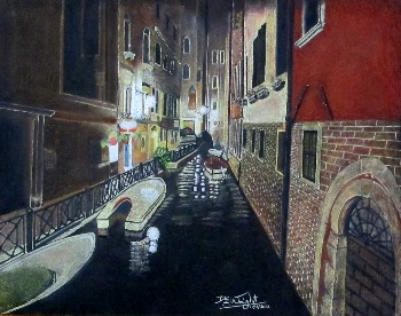
Months later, Peter attempted the same photo but on Somerset Velvet black paper, a slightly rougher surface. He began by using Caran d'Ache Supracolor aquarelles in white to block in lighter areas.
However, the rough paper left black flecks from the grain, which weren't ideal for the strong lights from the streetlamps and the water reflection.
The railings also presented a challenge due to the fine detail required to capture the light areas of the footpath behind them.
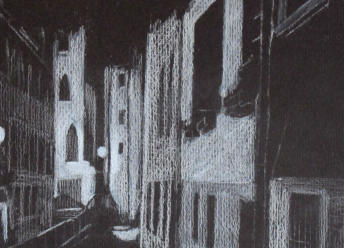
To address this, Peter used white pastel to block in the footpath area, as well as the top of the foreground boat, lights, and canal wall.
He blended the white pastel into the paper's grain and added a layer of white Supracolor, washing it in to bulk up the white pigment with the pastel.
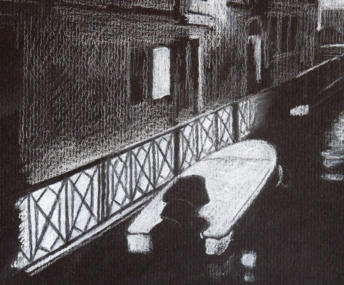
Once dry, he applied another layer of dry white Supracolor pigment. This created a solid white base that allowed him to draw the railings with a black Supracolor fine point, easier than trying to leave fine black lines from the paper surface.
Currently, the picture remains unfinished and is stored in Peter's "to do" file.
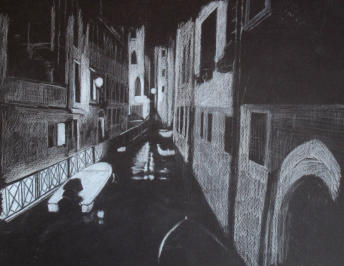
Alternative black papers
Peter was thrilled to try out the black Stonehenge paper from Legion Papers in the USA, which allowed him to conduct several course studies with his students.
While other black papers are available, most have hard surfaces and are not archival black. As previously discussed, using colored pencils on non-archival black paper can lead to the black fading, which is less than ideal.
Peter has a preference for two black papers: Stonehenge and UK-manufactured Somerset Velvet.
- Stonehenge has a soft printmaking surface that is absorbent and holds color well against a matte background.
- Somerset Velvet was also excellent, but it was discontinued in 2014 due to issues with the pigment used.
Fortunately, St Cuthbert's Mill introduced a new formula for Velvet paper in March 2019.
This newly pigmented black paper features a warm shade of intense black with a soft textured finish, similar to the other Velvet colors in the Somerset range. Peter was able to test a sample and compare it to the original.

In the digital comparison photo (taken on a grey day through a north-facing window) the two paper samples exhibit nearly identical surfaces and similar color absorption from Pitt Pastel pencils.
Notably, the new paper shows slight pigment loss in areas of heavier application on the test strip, whereas the old paper maintains better pigment retention.
Additionally, the new paper appears less black than the old one, a difference captured accurately in the photo. The old paper's deeper black surface enhances color intensity, making the applied colors appear more vivid.
The pencils sampled (from top left in each case) were:
- Prismacolor - Blue Slate
- Bruynzeel Aquarelle - 33 Red
- Caran d'Ache Luminance - white
- Faber Castell Polychromos - silver
- Derwent Drawing - Terracotta
- Staedtler Karat Aquarelle - white
- Faber Castell Pitt Pastel - white
- Derwent watercolour - kingfisher blue
Based on this brief evaluation, the new formula paper demonstrates high quality, though it may not surpass the previous version.
Nonetheless, it is preferable to not having access to this type of paper. Moreover, the new version is likely inferior only to Legion Stonehenge, known for its darker black pigmentation and excellent working surface.
White coloured pencil on black paper
While testing aquarelles and colored pencils on black paper Peter picked up a white pencil from his "Sundries" pot to compare it with a new brand he had received for examination.
To his surprise, the result on the paper was excellent—better than many other whites he had tried in the past in similar situations. The pencil was a Stabilo 'ALL' White pencil (8052), which is described on the shaft as "Aquarellable" and is also labeled as suitable for "Paper - Glass - Plastic - Metal."
Peter recommends acquiring one if you come across it in a listing.
Improve Your Pencil Art: Get Free Tips & Techniques
Sign up for our newsletter – just occasional emails packed with practical advice and inspiration for pencil artists like yourself



